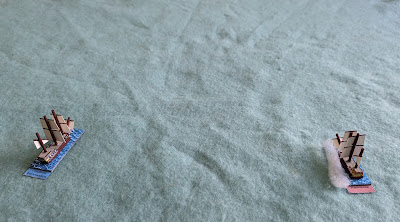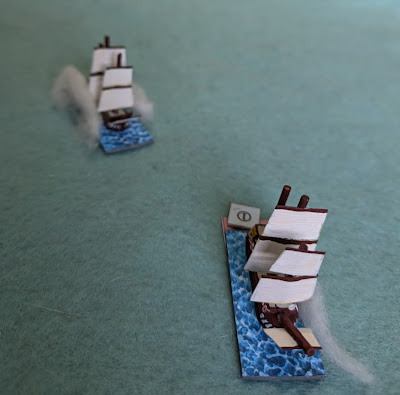During the ECW the Isles of Scilly, off the tip of Cornwall, were a hotbed of Royalist privateer activity. It was only in 1651 that a naval expedition extirpated them. It had secluded harbours and anchorages, and was well-garrisoned and fortified. Irish privateers also used it as a base.
This scenario sees a trio of Dutch ships carrying good from the West Indies who have, via a navigational error, strayed too close to this hotbed of privateers. A couple of small Irish vessels, backed up by a local ketch set out to intercept the rich prize that has landed on their doorstep.
Dutch
St. Barnabas, Curacao, Gouda - Q3 C2 - Galleon Rig, Merchantman, Razee, Shallow Draft, Yare
Privateers
Clontarf, Liffey - Q3 C1 - Lateen Rig, Razee, Shallow Draft, Swashbucklers, Yare
St Peter - Q3 C2 - Square Rig, Shallow Draft, Swashbucklers, Yare
The Dutch were sailing from bottom right to top left, with the privateers intercepting from the bottom left. This trapped the Dutch against the land.
An early shift of wind disadvantaged the privateers, though, and they had to use all of their tricks to close on an intercept course with the swift Dutch merchant vessels.
(The Dutch have Galleon Rig and Razee which makes them very fast in most wind attitudes).
Clontarf tried a long range shot, hoping to knock away some Dutch spars.
The lead Dutch ship, Curacao, returned fire and Clontarf was not only damaged but saw her captain felled. An inauspicious start for the predators.
Gouda also fired on Clontarf and damaged it some more. The Dutch were looking good not only to make their escape but to drive off the privateers as well.
St Peter closed up. Slower than the other ships on the table it did have well-manned guns and (relatively speaking) plenty of them.
Liffey fired a broadside into the stern of St Barnabas. To their consternation the Irish privateers saw their target catch fire!
Despite the loss of their captain reducing their chance of activating, Clontarf managed to run aboard Curacao, grapple and board.
St Barnabas blew up, and some of the wreckage set Liffey on fire.
Gouda attempted to slip past the privateers, shaving close to some rocks as it did so. But St Peter closed with it and boarded.
There were now two boarding actions on the go. The badly damaged Clontarf was, surprisingly, holding its own against Curacao, whilst St Peter was slowly whittling down the resistance of Gouda.
Gouda struck.
St Peter was able to cut grapples and quickly turn to the aid of Clontarf.
Outnumbered the crew of Curacao surrendered. To the right of the picture you can see Liffey, returning to the fray after extinguishing the fire on board.
The privateers had done fairly well, capturing two Dutch vessels whilst only suffering one damaged vessel themselves. And the game only took about 20 minutes to play, so I set it up again.
This time the Dutch had to pass through the narrow straits between two islands. The privateers were heading straight for them. As you can see, the faster sailing Irish privateers were well ahead of the slower St Peter.
Clontarf and Liffey approach the Dutch. There was no preliminary firing this time.
Clontarf took the initiative, grappling Curacao. It got the best of the initial attack, but a Dutch counterattack saw the action start to swing the Dutch crew's way.
Liffey tried to come to the aid of Clontarf, but didn't quite make it. It did manage to rake Gouda, killing the vessel's captain.
The crew of Clontarf rallied and with renewed vigour took the fight to the Dutch, pushing Curacao to the edge of surrender.
Gouda turned and raked St Peter, badly damaging it.
Liffey misjudged its attack on Curacao and collided with the Dutch ship. But the damage it did was enough to cause the Dutch crew to give up. Liffey was fortunate to escape with no damage.
St Peter also collided with Gouda. Both ships were damaged, but St Peter was now in a bad way.
A raking broadside from St Barnabas finished off St Peter, shattering it so badly that it sank
St Barnabas and Gouda were heading away from the fight. They would have a tricky turn through the wind to make it to their exit point, but they were in a position to escape.
But the Irish privateers were fast and nimble. Clontarf extricated itself from the captured Curacao and piling on sail, headed after the Dutch ships
Gouda damaged Clontarf with a ragged broadside, but Clontarf grappled, boarded and quickly captured the Dutch vessel.
Liffey had to make more of a turn to get back into the fight, and shaved some of the rocks very closely indeed.
St Barnabas engaged Clontarf, with both sides inflicting slight damage on each other.
But it was Liffey which swept in and grappled St Barnabas, its crew swarming on board the Dutch vessel like a tidal wave, sweeping all before them.
Clontarf also engaged, and St Barnabas struck.
So in this second game the privateers took all three Dutch ships, although they did lose St Peter. And Clontarf was the one to administer the finishing blow on all three ships.
I really enjoyed these two actions. It was fun using very fast manueverable ships with low combat factors. It does make the die rolls a lot more important, since a wide disparity is much more likely to see doubling or tripling of a target's score, but the unpredictability added to the game. The Dutch ships are tricky targets too; the merchantman trait makes them weak in boarding, but they are fast ships and can pull off a few surprises.











































































